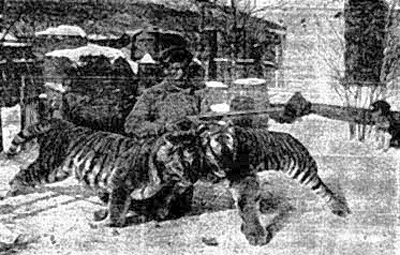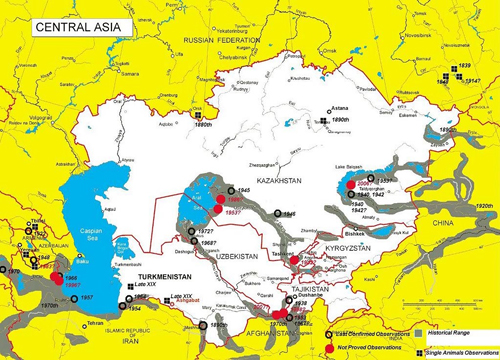
On May 27 Astana hosted a conference to discuss a new action plan of reintroduction of the Caspian tiger, also known as the Turanian tiger, in the Central Asian region. At the conference WWF Russia presented the plan of reintroduction of the tiger that is part of the restoration of the ecosystem.





On May 27 Astana hosted a conference to discuss a new action plan of reintroduction of the Caspian tiger, also known as the Turanian tiger, in the Central Asian region. At the conference WWF Russia presented the plan of reintroduction of the tiger that is part of the restoration of the ecosystem.
Tengrinews interviewed Deputy Chairman of the Kazakhstan Geographic Society Kanat Baigarin about the environmental initiative.
The Caspian tiger, also known as the Hyrcanian tiger, the Mazandaran tiger and the Turanian tiger, is an extinct tiger subspecies that had been recorded in the wild until the early 1970s, and used to inhabit the sparse forest habitats and riverines west and south of the Caspian Sea, from Turkey, Iran and east through Central Asia into the Takla Makan desert of Xinjiang, China. There are currently no individuals in captivity.

The Caspian tiger together with the Siberian and Bengal tiger subspecies represented the largest living felid and ranked among the biggest felids that ever existed.
During the Global Tiger Initiative-spearheaded international forum on saving tigers in St. Petersburg in 2010, the World Wild Fund (WWF) Russia, a branch of the world's largest independent conservation organization, along with the government and experts of Kazakhstan launched a new program to restore the population of tigers in Central Asia. The program involves restoration of the original ecosystems in the Ili River delta and the southern bank of Lake Balkhash, and creation of the Ili-Balkhash State Nature Reserve.
The Turanian or Caspian tiger became extinct in the area about 40 years ago and it was last seen In Kazakhstan near the Syrdarya River in the 1950s. Destruction of their natural habitat, poaching and extermination by Russian military in the 20th century is believed to be the main drivers of the extinction. In addition, reclamation of lands in the 19th century and hunting led to a significant decrease in availability of prey - wild boar and deer - that the tigers fed on.

The Caspian tigers inhabited northwestern China, eastern Turkey, the southern Caucasus, in northern Iran, Iraq, and in some regions of Central Asia. In Kazakhstan, particularly, the inhabited used to exist in riparian streaks of forests along the Syrdarya River in southern Kazakhstan, reed thickets of the southern shore of Lake Balkhash, the Ili River banks and Lake Alakul shore in southeastern Kazakhstan. The tigers also inhabited the Chui valley, Issyk-Kul lake area and Narynkol in southern Kazakhstan.
This map represents the Caspian tiger’s habitat places. Black circles display the confirmed area of tiger’s habitat, red ones – non-confirmed areas of its existence, grey circles show the habitat area, while black squares – cases of individual tiger occurrences.
Since tigers are on the top of the food chain, the project has to first restore the population of their prey base.

Bukhara deer
In the days past the tiers used to prey mainly on wild pigs and cervids, sometimes on Bactrian deer, roe deer, red deer, goitered gazelle, jackals, jungle cats, locusts, and other small mammals, on saiga, wild horses, Mongolian wild asses, and mountain sheep, on Manchurian wapiti and moose. They even used to catch fish in flooded areas and irrigation channels.
As part of the restoration program it is planned to focus on breeding wild pigs and deer for the prey base. The Ili River delta and southern shore of Lake Balkhash are considered to be a perfect place for this kind of prey.

There are large riparian forests, reed thickets, besides, there is some prey base consisting of boars and red deer there already. In addition, the Ily-Balkash Basin was one of the four main areas of tiger habitat in Central Asia. The region has around 1 million acres of land suitable for tigers.
The plan to reintroduce the tiger into the environment is designed for 15 years. It will include preparation of the tiger habitant areas, release of tigers into the wild and subsequent monitoring. Since there are no Caspian tigers left, Syberian tigers from Russia will be used as a substitute. They are similaraly large and represent the same group of felids. A genetic research was done to confirm that the Caspian tiger was genetically similar to the living Sybeiran tigers, also known as Amur tigers. The Sybeiran tigers will either be obtained rom zoos that have a lot of breeding pairs, or from their natural habitat in the Russian Far East.

Caspian tiger in the Berlin Zoo, 1899.
"Our goal is to bring the tiger population to 200 in 15-20 years. But even if we have only 100 by then, it will still be good progress," Kanat Baigarin said.
Reporting by Renat Tashkinbayev, writing by Assel Satubaldina, editing by Tatyana Kuzmina


 +7 (777) 001 44 99
+7 (777) 001 44 99















































